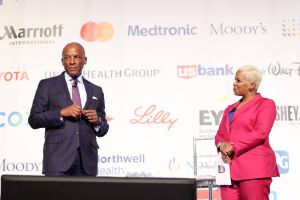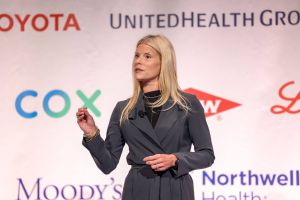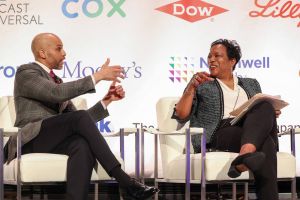During Fair360, formerly DiversityInc’s 2021 virtual event Leveraging Talent Data to Measure Fairness and Equity, panelists discussed the importance of approaching talent development data from all sides—and how this information can be processed to create the most accurate measures of fairness and equity possible within the corporate landscape. Panelists included Kia Painter, Vice President of Strategic HR Solutions at Cox Communications (No. 32 on The Fair360, formerly DiversityInc Top 50 Companies for Diversity list in 2021); Michael Johnson, Divisional Vice President of Diversity and Inclusion at Abbott (No. 4 in 2021); and Gretchen Stroud, Senior Vice President for Talent and Inclusion at Hilton (No. 1 in 2021). Lissiah Hundley, Chief Diversity and Inclusion Officer, Head of Strategic Partnerships and Client Fulfillment at Fair360, formerly DiversityInc, moderated the session. Here’s a look back at their conversation.
Hundley: Hello everyone, and welcome. So, I’m going to go ahead and jump right in, panelists. So, Kia, how does your organization track data and representation at all levels?
Painter: So, when we think about just how important the work that we do as a company is, around creating connections for people and our customers, we think about tracking this data, and we start with the totality of the employee life cycle. Employees experience all of your company — it’s not just these discreet things that happen in your life.
And so, when we track our data, we’re starting at the very beginning. How do we know that everyone knows about our great company? How are we outreaching to different organizations, to different places? When you begin to come into our company, what does your onboarding experience look like? Do you begin to feel that sense of belonging and inclusion immediately, because of this climate and this workplace culture that you’ve been introduced to?
Then we think about, what does that promotional process look like? How do you build your career? Are we ensuring that we’re creating access and opportunities for everyone? We then look at development: How are those investments in people being made in a way that is fair and equitable? And then, finally, as we think about rewarding our talent, how are we ensuring that we’re creating access, rewarding people for performance, and doing it in a way that it creates fairness for all of our employees?
So again, our approach is, we’re going to look at that totality, those key moments of truth in an employee’s experience with the company, and we’re going to make sure we’re tracking our data to ensure we have inclusion, diversity and equity infused into the core of those practices throughout those moments.
Hundley: Now, Michael, how do you leverage data to understand how inclusive your workplace is and how valued your employees feel?
Johnson: I think it really starts at first understanding clearly your goals because once you understand goals, you can start creating alignment and accountability around those goals, and you can start looking at the metrics and data that make the most sense in achieving them. I think too often we see companies jumping to transparency or sharing data without really clearly aligning those goals.
And there’s this thing that happens, they start equating transparency with accountability — and that’s just not true. And so when you have the goals, you can create the accountability that’s needed to drive the changes within your organization. Once we establish those goals, we then go ahead and try to socialize them internally and externally.
And that’s what we’ve actually been doing now at Abbott. We put our goals out on our website for many people to go ahead and comment on, and we’ve had many people comment on them. They help us understand if they’re the right goals. Are they too aggressive? Are they not aggressive enough? Are they in the right areas? We do that with our employees. We’re actually doing a virtual roadshow this month and the previous months to make sure that people understand them. And that’s how you create the accountability. People begin to see themselves inside those talent goals that you start having, and the metrics start to become a little bit more obvious as well as the roadmap to get there. Our talent goals are largely around representation, development and supporting our employees. So, naturally, our metrics are there as well.
And when we think about development, an example I would give is development equity. We look at certain programs that we know are going to go ahead and propel leaders to broader responsibility within our organization. If we don’t see the right demographics that align with the metric that we’ve established to help us reach our goal, then we start asking ourselves why. We start trying to diagnose that, and then we work to remedy it.
Now, development equity is actually really important for us in our metrics, because we think the talent that we develop can allow us to be more nimble, more responsive to customers and actually promote our culture of inclusion in a way that external hires can’t always do. It’s not that we aren’t confident that we can’t hire externally. We can — we have metrics around that too, and they show we can do that really well.
But when you’re really trying to propel an organization, internal talent development becomes really important. When you start talking about how employees feel, I’d be remiss not to talk about quantitative and qualitative data. And I think both are really, really important when you start thinking about how employees feel. We’re really all in on employee listening. And we do that in a quantitative way, through quarterly surveys that we do with our 109,000 employees globally.
We believe that there are a few indices. We like the Gallup Equity, Diversity and Inclusion Index, we believe it’s relatively well-validated, and can kind of speak to how that culture of inclusion is playing out across the world. But we also have our executives looking for qualitative data through skip-level meetings that we call “Let’s Talk” meetings, and they hold these on a regular basis to try to understand how we can eliminate barriers to creating an inclusive workforce for all of our employees. It’s incredibly important to us, so that’s how we do it.
Hundley: The data tells a story, right? We all know that, and the reference to the “skip levels” and the “Let’s Talk” meetings, I really, really like that concept, so thank you for sharing that. So, Gretchen, to the same question?
Stroud: So this was my strategy all along, I wanted to go after Michael, so I could build off of his answer. So really, as you think about organizational effectiveness, we too truly believe that building that pipeline from within is critical to business continuity, to organizational culture and kind of sustaining that great culture that we’ve built at Hilton over time.
We also hire from outside the organization, but looking at development program representation at every single level of the organization is critical to us. So it’s not just the level below VP or below executive that matters. Are you developing your team members from the day they step in the door, entry-level all the way up through executive? We also look at lateral movement as well as promotion. So a lot of organizations look at promotion rates, but those lateral moves can be an important catalyst for long-term success in the organization.
And so, do we make sure that we’re moving people from line-level or supporting function roles into operational roles, potentially as a lateral move at the moment, but to prepare them for a longer career trajectory here at Hilton?
And then the last thing is the attrition rate. Attrition is a major threat to organizational effectiveness in any company, and so you need to be looking at your attrition rates and the story that they’re telling you. Obviously, there’s a natural amount of attrition in any organization, but when we really dig into that attrition, are we losing more women than men? Are we losing more Black team members than other ethnic groups across the organization? And if so, how do we dig into that data to really understand what is going on? When we say we are creating a great place to work that’s inclusive for everyone, are we really doing that, or is the data telling us that there’s something that maybe we need to tweak or do better in order to retain great talent that we’ve invested in? We develop them, we’ve moved them around. We want to make sure that we’re retaining them so that we can build that long-term pipeline.
Hundley: Kia, what are some best practices for tracking talent data?
Painter: The first one I tell everyone to start with is, what are you trying to solve for? Before you just go into tracking, what is your strategy? What are your business goals around innovation and growth? What are the types of people you’re going to meet? What are the types of capabilities you’re trying to build for your business? So start first with that — what those things are that you’re really trying to answer about leveraging talent to step into our business opportunities or solve any challenges we might have. And then once you understand those questions, you begin to think about how you want your data to not only provide you with insights but also how you might then leverage that data to tell the story to the people who have to support you in making decisions to invest in talent.
I’ll give an example. I’m sure a number of companies invest a lot of time in their succession and talent processes. And one of the metrics we often set times is around talent readiness. And while it’s OK to have a different diversity representation on your slate, if you’re really not unpacking what could be the causal issues for readiness not progressing for some versus others, it doesn’t matter that you have diversity when your slates — you’re not going to get the outcomes that you want. And so, one of the things that we looked at over the course of about three to four years is, in understanding the implications of readiness by measuring that now we know, oh, we have to go after certain experiences for people to close the gap in readiness. So now we have to invest in and reshape our Executive Development Program.
So, now we’re taking different actions because of understanding our data. Oh, now if we’re going to build this capability, we’ve got to start being on the lookout for, maybe, talent external to the organization, or figuring out how we’re going to build that or use transportable skills from other parts of our organization. So that’s the first best practice, really understanding what you are trying to solve for.
The second best practice, I would say, would be, you have to make sure — OK, so you just track this information, how is this information getting in the hands of people who are making not just financial decisions for the company, making decisions about how we innovate the types of products and services that we sell to our customers? That same information about our talent should be in that same suite of information from a business practice perspective that our decision-makers are making.
And that’s one of the things I love about our talent process. Our senior executives expect to have that data around inclusion and diversity: How are we doing? What progress are we making? And not just from an activity perspective, but really, are we getting outcomes? So I would say again, from a best-practice perspective, understand the questions you are going after, ensure that you are engaging people who make decisions about talent for the company.
And then the final best practice I would say is, look at all of your talent data together, tell the broadest story that you can. And an example I would offer with that: You can do a lot to recruit people into your organization, you can do a lot to promote and develop, but if your culture isn’t a culture that creates that kind of “stickiness” — where people want to pull out that discretionary effort to help you build a great business — then what is all of that data for?
And so, I would just encourage as a best practice to link your talent data, link your engagement data, your culture data, any indexes you’re doing around inclusion in your environment, you should thread that into a broader talent story for how you are really ensuring that not only are you creating these programs, but your people believe that there’s fairness and equity in your company.
Hundley: Really good stuff — I mean, how many times do you hear the question: So, how do I even establish my succession-planning process? Or there is some strategic work and planning that goes into that. And Gretchen, we’re going to transition because I have another question for you: How can talent data drive equity and fairness in a company? Just looking at the work that you do in your organization…
Stroud: Great question, and important. Look, I think we all have our own perspective on equity and fairness, right? We see what we see, but we don’t see what we don’t see. And that’s why the data is so important: Because it’s objectively telling us the reality — not what we feel in our gut or what we think is happening or what is the most recent experience that we had, but what is actually happening over time, as an accumulation of decisions that we’ve made over and over and over again.
And so, as you think about using talent data to drive equity and fairness, there are a few things that really are critical to that work. First, you really want to think about, what are the outcomes you’re trying to drive? Then use the data to tell you, are you driving those outcomes? So, if your outcome is to drive a more diverse cadre of leaders at certain levels, are your hiring decisions, are your promotion decisions, are your development-program decisions making that possible? Do those future leaders have mentors and sponsors?
It’s not enough to just think they do. You have to know: Do they? And then really double-clicking on that data to make sure that you’re focusing on the right things. So for example, if you are trying to drive a higher promotion rate of Black team members in the organization, we also have to look at, how are we preparing them to be ready for that promotion? Do they have a sponsor? Have they been in some of our signature development programs? Are we giving them access to other development? Are they getting feedback from their manager and other people in an objective and actionable way? All of that drives the actual outcome of the promotion rate that you’re measuring and is important data to really understand if you want to drive change.
I think the other thing that happens sometimes, though, is organizations get a little bit stuck with analysis paralysis. And so they get the data, they study the data and then they just keep studying the data. At some point, you have to take the data and start making action for change. And so, one of the things that over time I think I’ve seen is, the data doesn’t always tell us a story that we’re really proud of at the moment, so we get stuck trying to, well, “Let’s assess it a little bit more, let’s understand. Well, there was this one situation that really made this data the way it is…” And so, really, data is data. Data is telling you objectively what is happening, and none of us are perfect, I think that’s the message that we all need to embrace on this journey.
There’s not one company in the entire world that is doing this perfectly, and that is why we’re all doing this work and why we’re in it together. And so don’t be afraid or ashamed to look at your data. You have to understand the data, take the objective information that it’s giving you, and then create an action plan to make a change. It’s the only way we’re going to drive progress.
Hundley: So, action is critical. And Michael, quick question for you. So, we have this large supply, a good supply of talent data, but what should you be doing with the data you’ve acquired to positively impact your workforce and get quicker real-time results?
Johnson: I think it’s two things. One is, I do think we do need to have a penchant for action. But I also think that there’s an element of making sure that the data you have allows you to draw conclusions. Sometimes it’s not just human capital data you need, sometimes it’s business metrics that you need to fully understand it. A financial metric — maybe information externally to contextualize what the information is sharing with you, or the data is telling you.
One thing we believe in is co-creation, so what we then do is oftentimes work with different teams that can help us identify the correct solution to help it propel our talent to be more successful. Oftentimes it’s ERGs, oftentimes it may be another area of HR. Maybe sometimes it’s a functional area that we hadn’t thought of before. But when you involve other people, this idea of co-creation, what it does is it allows you to filter out any disconfirming evidence around solutions that you want to go with. And I think that ensures that the solution you do ultimately use will positively impact your workforce — it’ll actually work.
Hundley: So, when it comes to the talent data, if you could give us two or three kinds of data that matter the most to you, share that with us, what matters the most?
Johnson: I can start. I would say our employee listening data is pretty important to us, right? This gives us a real-time pulse on some things that we need to address short-term and long-term. As I mentioned before, our development equity data is also very, very important to us. It’s another indication of the spirit that we have here at this company that we can positively impact the lived experience of all of our employees, to help them contribute and maximize their potential so that they can help others do it. So those would be two pieces that really jump out at me.
Painter: So, I’ll add there, this changes in time. I would say for this moment right now because so many organizations have made commitments about seeing the growth for women and people of color in executive-level positions, what’s most top-of-mind for me right now in terms of talent data is, are we actually seeing movement? And are we having our data collected, shared and acted on in a way that we make investments to continue to sustain the growth of diverse talent in the executive ranks?
The second piece of data that I’m watching right now is actually on the reward side. In a more macro sense, oftentimes organizations are trying to figure out this whole pay parody when you see women, often, and people of color, who just from a total-income perspective often lag behind others. And so, how do we begin to look at getting people in careers that may command more from a rewards perspective, so we begin to close that gap from a pay equity perspective? So those are the two things that are top of mind for you right now from a data perspective.
Stroud: I’ll add on to that. For us, team-member feedback and team-member sentiment is essential at this point in time. There has been massive emotional trauma, I think that almost all of us have experienced over the past 12 months through the pandemic, through the murder of George Floyd and all of the aftermath of that. And unfortunately, we continue to see hate against Asian Americans, continued killing of Black Americans at the hands of others. And that creates a lot of pain for our team members that we need to truly understand because they don’t leave that at the door when they walk into work.
And so, we need to understand the mental wellness of our employee population, and what we can do to continue to support them as they move through the impact the pandemic has had on our industry and many others as we continue to move forward as a country for, hopefully, a more just and equitable society. Really understand, what are those points? And then, how can we as an organization do whatever we need to do to support our team members to be able to thrive in all of the most important ways?
Stroud: I would say, absolutely all of the other data we talk about is important, but at the end of the day, we are all human beings and we have to care for each other in a way that is going to make progress sustainable and allow all of us to continue to show up or to be our best selves and be supported by our colleagues as our best selves when we’re at work.
Hundley: And we touched on this a little bit earlier, but your talent data — how does it positively impact your company’s culture as well? Because it’s driving that people piece of the business, as well as your customer piece. If you could share a little bit more on how your talent data is positively impacting your workforce and culture, that would be great as well, team.
Johnson: Well, one thing I would highlight is, the previous question’s hard, and this one is hard because there are all these different pieces of data that kind of build that picture of the culture. One thing that I think some of the previous panelists spoke to is this element of disaggregating the data; it actually helps you get closer to where you can positively impact that culture. In addition, some data helps you positively impact the business.
For example, things that happen with our ERGs. Our ERGs and understanding how well they impact the business are so tremendously important. One of our ERGs, our “Women’s Leadership at Abbott” ERG is one of the reasons that we’re doing so much work around health equity and diabetes, they actually introduced this work to our organization.
It’s one of the reasons why we are the founding sponsors in the American Diabetes Association, Health Equity Now initiative, along with other healthcare partners. But we are there and we were introduced to the topic through one of our ERGs. So making sure you understand that talent data, all these different places can be really, really important, and don’t miss it when it comes to your ERGs, because, for us, we found that to be incredibly impactful.
Stroud: I’ll add on the ERG point. I think talent data, we are in the data all day, every day, and as HR practitioners, you have this wealth of data that you’re looking at. One of the things that we’ve learned over the last several years is, it’s not enough to look at the data internally and know with your leadership that you’re making progress if your team members don’t feel like they’re seeing that progress.
So you may be making progress, but if your team members don’t feel like they’re part of that journey, then it is not really reflected as true progress. And that’s one of the reasons why we earlier this year released our diversity data publicly and transparently because we wanted all of our team members and our guests and our customers to have access to the work that we’re doing.
We readily acknowledge that we’re not anywhere close to perfect, and this work continues. But having that transparency, so people can come on that journey with you, is really important because it’s not enough to say, “We’re making progress.” You have to show that you’re actually doing it so that your team members feel like they’re part of that process.
Hundley: I agree completely. Any other final words as we close out our session team?
Johnson: I would just highlight the need to look at the data internally and externally. I think it’s allowed us to focus on some priorities that are a little bit longer term. For us, that is really related to STEM. And when we start thinking about STEM talent in the workforce, it’s one of the reasons why we’ve put a lot of different initiatives in place to support it. External and internal data together can help drive initiatives that can propel your company as well as an industry.
Hundley: Wonderful. Thank you so much, panelists, for joining us today. It has been a pleasure.


















